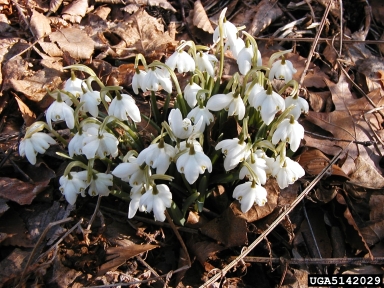Since it's February, I'll bet we all are starting to get cabin fever. We have been hiding in our warm homes all winter long because of the cold temperatures. With cabin fever comes the anticipation of spring and all of the beautiful flowers that will soon come out of the bland winter landscape. We can enjoy spring sooner if we plant some bulbs that bloom in the very early spring, such as snowdrops.
The common snowdrop, Galanthus nivalis, is a beautiful bulb that blooms in March to April, depending on the weather each year. It is in the amaryllis family. This plant has narrow, grass-like leaves that emerge in the late winter. It then blooms with a white flower that hangs down off the flower stalk, similar to a shepherd's crook. The flower has tepals, not petals, which are petals that are not completely divided. After snowdrops bloom, they go dormant for the year. Snowdrops only grow to be 4-6 inches tall. Although a short lived plant, it adds an early burst of spring to your otherwise dormant landscape early in the spring.
Often people plant the straight species of common snowdrop, although there are many other varieties to plant in our landscapes. According to Gerald Klingaman from the University of Arkansas Research and Extension, 'Floro Pleno' is one variety that has double flowers for more visual interest. 'Vividi-apice' is another variety that has green spots on the tips of the tepals. Another species is called Giant Snowdrop, Galanthus elwesii.
Snowdrops do well in the understory of trees, as they prefer part shade to shade. They also prefer to be kept moist, but must be planted in well-drained soils. They will naturalize quite readily given good growing conditions. The bulbs of snowdrops are often dug up by squirrels and mice and since this plant is not present throughout most of the year, they need to be protected. To protect snowdrops from squirrels and mice, cover the bulbs with chicken wire and then soil when you plant them. The plants will grow through the mesh of the chicken wire.
According to the Royal Botanic Gardens of Kew, snowdrops can be used to help ease the problems with Alzheimer's disease. This is due to the presence of the alkaloid galanthamine. Snowdrops also contain a lignin that can be used as an insecticide. It may even be possible to genetically engineer the lectins of snowdrops into plants such as tomatoes for insect resistance, but that is still being researched.
Snowdrops are beautiful bulbs to plant on your acreage or in any landscape. This perennial will bring spring to your landscape before most of the other plants start to emerge and bloom. This is a great plant to brighten up areas underneath your trees that are usually quite boring. Snowdrops are small plants that emerge and bloom, and then go dormant again before any other plants come out of dormancy. It can be placed in many different locations throughout your landscape, on an acreage or otherwise.

